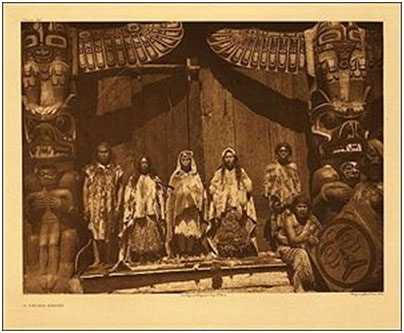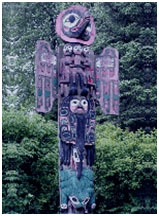Northwest
Coast Winter Ceremonies
Presented by Roy Cook
 The Northwest
Coast American Indian Potlatch is a festival ceremony practiced by indigenous
peoples of the Pacific Northwest Coast. This includes Haida, Nuxalk, Tlingit,
Tsimshian, Nuu-chah-nulth, Kwakwaka'wakw, and Coast Salish cultures. The
word comes from the Chinook trade language, meaning "to give away"
or "a gift". At potlatch gatherings, a family or hereditary
leader hosts guests in their family's house and holds a feast for their
guests. The main purpose of the potlatch is the re-distribution and reciprocity
of wealth.
The Northwest
Coast American Indian Potlatch is a festival ceremony practiced by indigenous
peoples of the Pacific Northwest Coast. This includes Haida, Nuxalk, Tlingit,
Tsimshian, Nuu-chah-nulth, Kwakwaka'wakw, and Coast Salish cultures. The
word comes from the Chinook trade language, meaning "to give away"
or "a gift". At potlatch gatherings, a family or hereditary
leader hosts guests in their family's house and holds a feast for their
guests. The main purpose of the potlatch is the re-distribution and reciprocity
of wealth.
 Different
events take place during a potlatch, like storytelling, singing and dances,
sometimes with masks or status regalia, such as Chilkat blankets. For
many potlatches, spiritual ceremonies take place for different occasions.
This is either through material wealth such as foods and goods or non-material
things such as songs and dances. For some cultures, such as Kwakwaka'wakw,
elaborate and theatrical dances are performed reflecting the hosts' genealogy
and cultural wealth they possess. Many of these dances are also sacred
ceremonies of secret societies like the hamatsa, or display of family
origin from supernatural creatures such as the dzunukwa. Typically the
potlatching is practiced more in the winter seasons as historically the
warmer months were for procuring wealth for the family, clan, or village,
then coming home and sharing that with neighbors and friends.
Different
events take place during a potlatch, like storytelling, singing and dances,
sometimes with masks or status regalia, such as Chilkat blankets. For
many potlatches, spiritual ceremonies take place for different occasions.
This is either through material wealth such as foods and goods or non-material
things such as songs and dances. For some cultures, such as Kwakwaka'wakw,
elaborate and theatrical dances are performed reflecting the hosts' genealogy
and cultural wealth they possess. Many of these dances are also sacred
ceremonies of secret societies like the hamatsa, or display of family
origin from supernatural creatures such as the dzunukwa. Typically the
potlatching is practiced more in the winter seasons as historically the
warmer months were for procuring wealth for the family, clan, or village,
then coming home and sharing that with neighbors and friends.
 Within
it, hierarchical relations within and between clans, villages, and nations,
are observed and reinforced through the
Within
it, hierarchical relations within and between clans, villages, and nations,
are observed and reinforced through the
distribution or sometimes destruction of wealth, dance performances, and
other ceremonies. The status of any given family is raised not by who
has the most resources, but by who distributes the most resources. The
hosts demonstrate their wealth and prominence through giving away goods.
A Tribal elder said, "We will dance when our laws command us to dance,
and we will feast when our hearts desire to feast. Do we ask the white
man, 'Do as the Indian does?' It is a strict law that bids us dance. It
is a strict law that bids us to distribute our property among our friends
and neighbors. It is a good law. Let the white man observe his law; we
shall observe ours. And now, if you come to forbid us dance, be gone.
If not, you will be welcome to us."

Celebration of births, rites of passages, weddings, funerals, naming,
and honoring of the deceased are some of the many forms the potlatch occurs
under. Although protocol differs among the Indigenous nations, the potlatch
will usually involve a feast, with music, dance, theatricality and spiritual
ceremonies. The most sacred ceremonies are usually observed in the winter.

The totem carvings
tell a story that are revealed only if one knows the meaning assigned
to various animals, fish, birds and designs and where they are placed
on the pole. There were a number of reasons why a particular figure or
design was chosen by a clan. The connection between the clan and the various
figures carved into the pole may have been as a result a special gift
from the animal, fish or bird spirits. Or, there may have been a recent
encounter with that figure. Some clans claimed to be descended from certain
totem figures.
 The
meaning of many totem poles is lost with time. Even some of today's totem
poles cannot be understood except from one person - it's owner. Understanding
the symbolism and stories hidden within
The
meaning of many totem poles is lost with time. Even some of today's totem
poles cannot be understood except from one person - it's owner. Understanding
the symbolism and stories hidden within
the totem pole is more than a simple exercise in learning the attributed
meanings of the figures. It is possible to know the meaning assigned a
figure by the people of the Northwest, but it is not always possible to
know its significance to the over-all story.
Totem figures are not Gods. Totems are not worshiped like religious icons nor used as a talisman. They were never used to ward off evil spirits and claims of bizarre, magical "totemism" practices are fiction. A totem pole may be compared to the symbolism portrayed in the Great Seal of the United States or a Coat of Arms. These national emblems are roughly equivalent to the meaning bound up in a totem pole except they identified clans not an entire nation.
It is important to note the differences and uniqueness among the different cultural groups and nations along the coast. Each nation, tribe, and sometimes clan has its own way of practicing the potlatch so as to present a very diverse presentation and meaning. The potlatch, as an overarching term, is quite general, since some cultures have many words in their language for all different specific types of gatherings. Nonetheless, the main purpose has been and still is the redistribution of wealth procured by families. The cultural orientation that has been the focus of governments and religious missionaries’ frustration is the acceptance that the status of any given family is raised not by who has the most resources, but by who distributes the most resources. The Potlatch hosts demonstrate their wealth and prominence through giving away goods. All things are the gift of the Creator to be shared and benefit all the people.